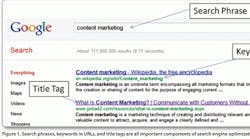Almost all HVACR contractors understand the importance of their websites, specifically the importance of bringing customers to their sites through search engines such as Google.
The problem is that the majority of HVACR contractors don't track the analytics from their websites. That means that most contractors have no idea how people are getting to their websites, or what they do once they get there.
This is a big problem. Before you can do anything with your website that will make an impact on your business, you need to understand what it’s doing for you. Google Analytics is 100% free and will tell you where your traffic is coming from and where customers are going on your site. It takes 10 minutes to set up. That's step one.
Step two is making sure you have the right equipment on your web pages. This is called search engine optimization (SEO). Just as a contractor's job is nearly impossible without the right equipment, the same goes for the pages of your website. A recent Content Marketing Institute article (http://bit.ly/HVAC-SEO) runs through the basics of what you need on your website to allow you to be found by your customers. These include:
Title tags. The single most important on-page SEO factor is the title tag. If you want a page to rank for a specific keyword phrase, make sure that phrase is in the title tag. Description meta tags. Meta descriptions are what search engines typically (but not always) display in your page's search results snippet under the title tag. For an example, see Figure 1.
Keywords in the URL string. Again, see Figure 1. These are keywords separated by underscores.
Content and keyword density. Never get caught up in how many times you've used your exact target phrase in your content. If keywords are relevant and aligned with that page's content, as they should be, then they will naturally fall into place.
Internal links and anchor text. The clickable text of a link is known as "anchor text." Anchor text can be a very important signal to search engines of what that linked page is about. One of the most crucial ways to use keywords across your website is in the anchor text of internal links from one page on your site to another.
Step three is all about getting other credible websites to link to your content. The more credible businesses and bloggers that link to your content, the more Google sees your site and pages as helpful, thus raising your pages in the search rankings. There are two ways to make this happen:
1. Consistently create great content. Just because you put up a website with all your products and services doesn't mean your website is complete. In order to keep Google's attention and have people link to your content, you need to create helpful content for your customers all the time. Most HVACR contractors do this through a blog. For example, Conditioned Air in Naples, Florida (by way of disclosure, a SocialTract customer) gets more than 1,000 visits per month to its blog site. Sixty percent of that traffic comes from Google. To get those results, Conditioned Air blogs at least twice per week, focusing on customer problems and pain points.
2. Market your content. Most times, people won't initially find your content unless you get their attention. Spreading around your content to customers and regional influencers will start to put you on the map so you can get those inbound links. Examples of this include:
- Twitter, Facebook, LinkedIn, and Google+
- RSS and blog-to-e-mail feeds
- E-mail newsletters
- Guest blogging (posting content on other people's sites with links back to your site)
- Guest webinars
- News releases (with links to your great content)
- eBooks and white papers (content packages for customers and influencers).
If this is done correctly, you'll get a fair share of short-tail SEO (this means search terms such as "air conditioning boston") and long-tail SEO (for example, "fixing a programmable thermostat in New England").
If you get stuck on what content to create for your customers, just heed this advice from Marcus Sheridan, CEO of River Pools and Spas, Warsaw, VA, who became the best-selling fiberglass pools contractor in the country through these strategies:
"Have you and your technicians write down all the questions your customers ask you. From that, start developing content that you can post online to answer those questions. Repeat and watch your business grow."
Joe Pulizzi is CEO of SocialTract (www. socialtract.com), a blogging service for HVACR contractors. SocialTract provides web content for contractors who don’t have the time to do it themselves. SocialTract is a division of the Content Marketing Institute, a media company covering the content marketing industry. For more information, visit ContentMarketingInstitute.com. To check out Pulizzi’s new book, Managing Content Marketing, visit managingcontentmarketing.com, or e-mail joe at [email protected].







